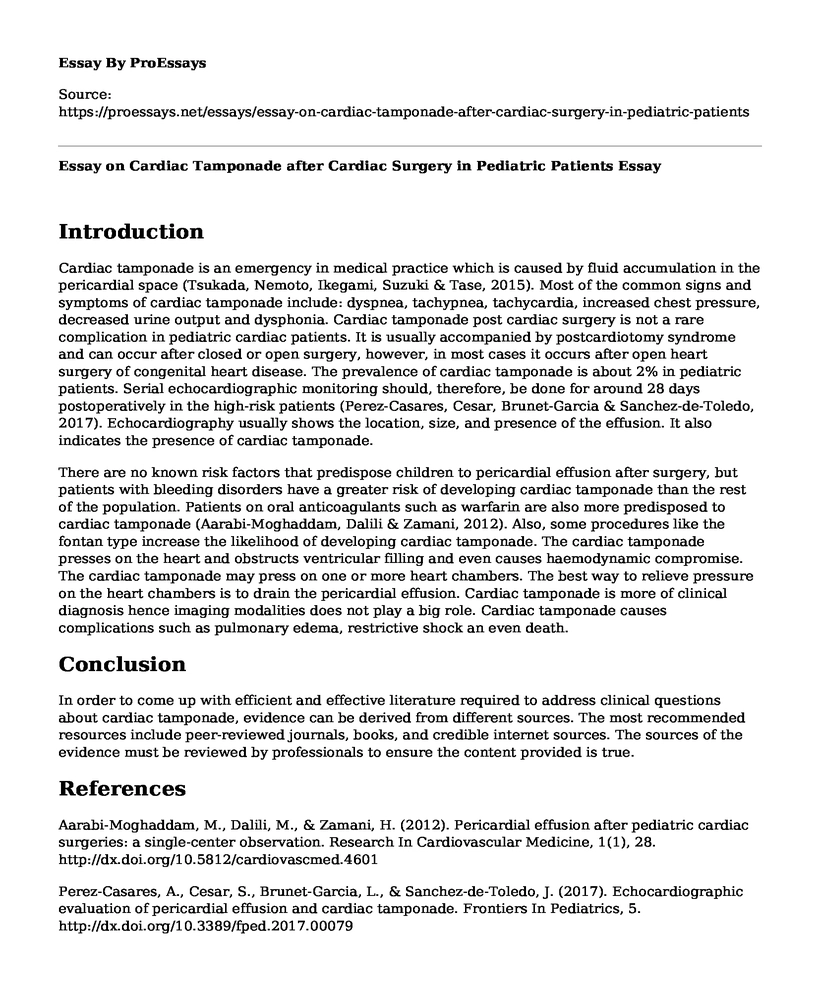Introduction
Cardiac tamponade is an emergency in medical practice which is caused by fluid accumulation in the pericardial space (Tsukada, Nemoto, Ikegami, Suzuki & Tase, 2015). Most of the common signs and symptoms of cardiac tamponade include: dyspnea, tachypnea, tachycardia, increased chest pressure, decreased urine output and dysphonia. Cardiac tamponade post cardiac surgery is not a rare complication in pediatric cardiac patients. It is usually accompanied by postcardiotomy syndrome and can occur after closed or open surgery, however, in most cases it occurs after open heart surgery of congenital heart disease. The prevalence of cardiac tamponade is about 2% in pediatric patients. Serial echocardiographic monitoring should, therefore, be done for around 28 days postoperatively in the high-risk patients (Perez-Casares, Cesar, Brunet-Garcia & Sanchez-de-Toledo, 2017). Echocardiography usually shows the location, size, and presence of the effusion. It also indicates the presence of cardiac tamponade.
There are no known risk factors that predispose children to pericardial effusion after surgery, but patients with bleeding disorders have a greater risk of developing cardiac tamponade than the rest of the population. Patients on oral anticoagulants such as warfarin are also more predisposed to cardiac tamponade (Aarabi-Moghaddam, Dalili & Zamani, 2012). Also, some procedures like the fontan type increase the likelihood of developing cardiac tamponade. The cardiac tamponade presses on the heart and obstructs ventricular filling and even causes haemodynamic compromise. The cardiac tamponade may press on one or more heart chambers. The best way to relieve pressure on the heart chambers is to drain the pericardial effusion. Cardiac tamponade is more of clinical diagnosis hence imaging modalities does not play a big role. Cardiac tamponade causes complications such as pulmonary edema, restrictive shock an even death.
Conclusion
In order to come up with efficient and effective literature required to address clinical questions about cardiac tamponade, evidence can be derived from different sources. The most recommended resources include peer-reviewed journals, books, and credible internet sources. The sources of the evidence must be reviewed by professionals to ensure the content provided is true.
References
Aarabi-Moghaddam, M., Dalili, M., & Zamani, H. (2012). Pericardial effusion after pediatric cardiac surgeries: a single-center observation. Research In Cardiovascular Medicine, 1(1), 28. http://dx.doi.org/10.5812/cardiovascmed.4601
Perez-Casares, A., Cesar, S., Brunet-Garcia, L., & Sanchez-de-Toledo, J. (2017). Echocardiographic evaluation of pericardial effusion and cardiac tamponade. Frontiers In Pediatrics, 5. http://dx.doi.org/10.3389/fped.2017.00079
Tsukada, Y., Nemoto, C., Ikegami, Y., Suzuki, T., & Tase, C. (2015). Cardiac tamponade after extracorporeal cardiopulmonary resuscitation. Acute Medicine & Surgery, 3(2), 214-215. http://dx.doi.org/10.1002/ams2.128
Cite this page
Essay on Cardiac Tamponade after Cardiac Surgery in Pediatric Patients. (2022, Apr 07). Retrieved from https://proessays.net/essays/essay-on-cardiac-tamponade-after-cardiac-surgery-in-pediatric-patients
If you are the original author of this essay and no longer wish to have it published on the ProEssays website, please click below to request its removal:
- A Policy Brief: Maternal Health in Rural Africa
- Essay Example on Staff Shortage and Its Implications in Healthcare Institutions
- Cancer Review Research Example
- Peer Reviewed Article: Health Care Issues for Veterans
- Public Children Services Organizations Analysis Paper Example
- Essay Sample on Mixed Anxiety/Depression & Substance Use: Effective Diagnosis & Treatment
- Medical Malpractice: 10,000+ Suits Annually in US Despite Regulation - Essay Sample







